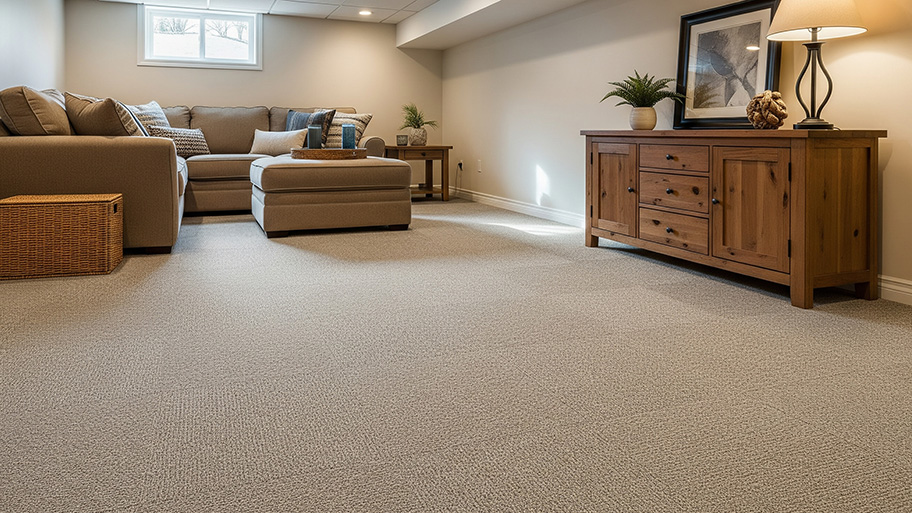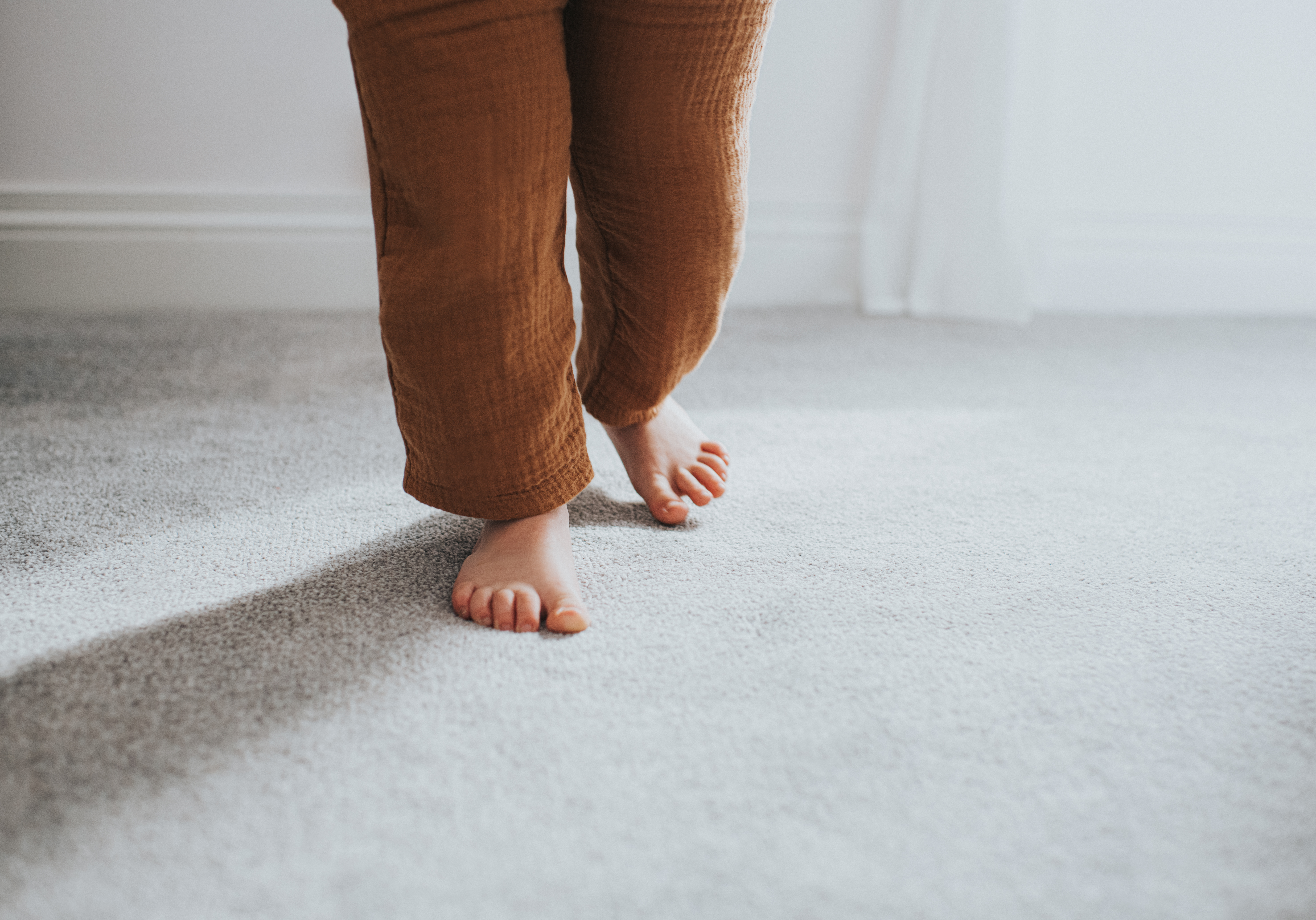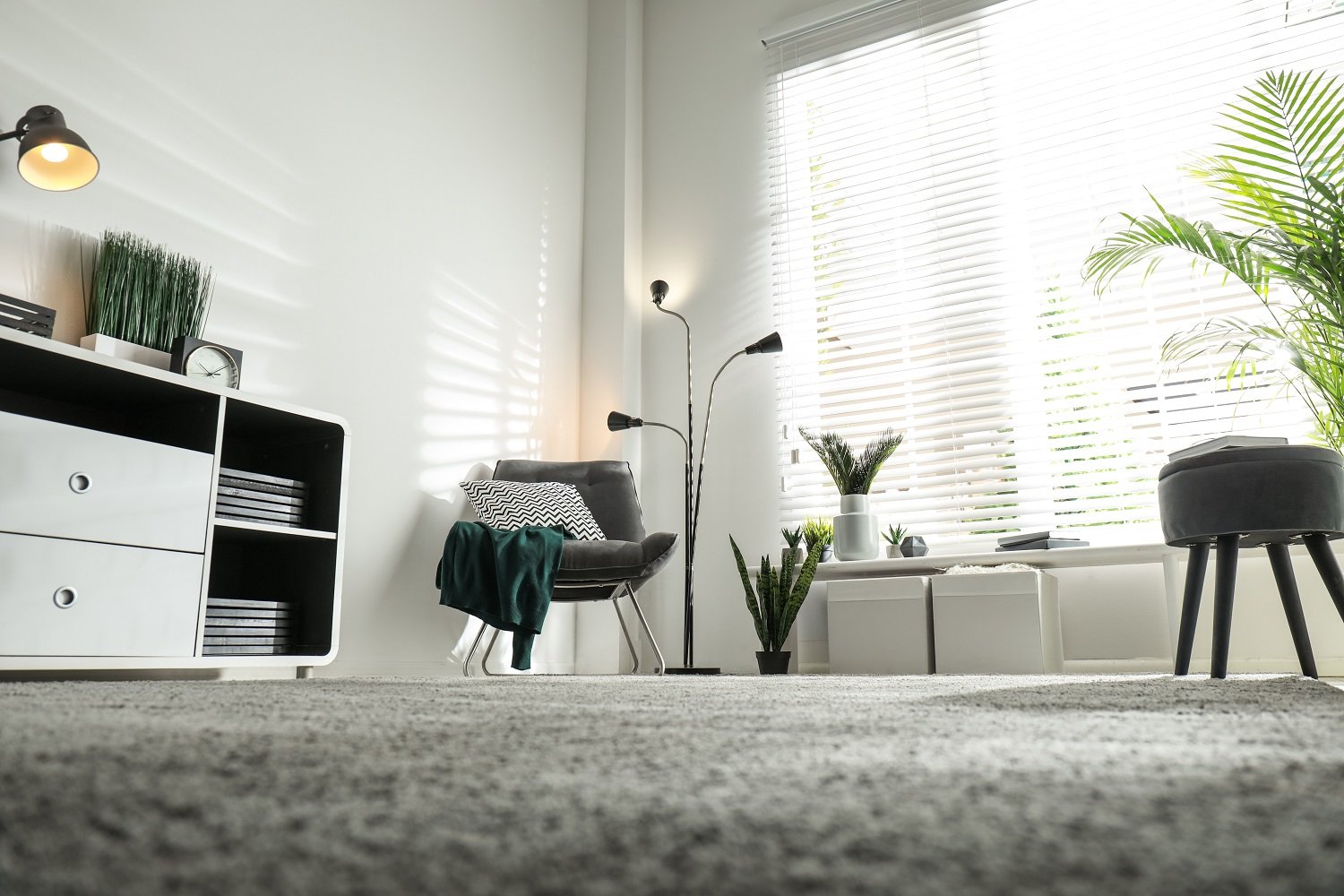
The cost to carpet stairs depends on the number of stairs, material choice, and staircase type. Read on to calculate your project expenses
Carpet installation costs depend on your project and location. Check with a local pro for your specific job.
The cost to replace carpet depends on factors such as the carpet material, size, style, and labor required.
Carpet is often sold by size, with prices ranging from $30 to $50 per square yard.
Nylon carpet ($2–$5 per square foot) is the best choice for its cost-effectiveness and longevity, although polyester ($1–$3 per square foot) is the most affordable option.
By removing and disposing of the old carpet and padding yourself, you can save up to $5 per square foot on your total replacement cost.
Carpet should be a top pick for anyone who prefers softness underfoot and warmth during the colder months. If you’re installing 330 square feet of carpet—the size of an average living room—your carpet replacement cost should be around $1,780. Carpet replacement costs often range from $781 to $2,812, including the carpet and padding, installation, and removal and disposal of existing flooring. Review the cost factors below to start budgeting.
Factors to consider when determining carpet replacement costs include the size of the area you’ll be carpeting, the material you choose, the type of carpet padding or underlayment, and the labor.
Square footage is one of the biggest factors when budgeting for the cost to install new flooring. It costs anywhere from $3 to $11 per square foot to install carpet throughout the home, with this price rising or falling according to the type of material and any unforeseen obstacles encountered during the placement process. Carpet is often sold by the square yard, so you can expect to pay $30 to $50 per square yard.
Here’s a breakdown of carpet replacement costs based on square footage:
| Square Footage | Average Cost |
|---|---|
| 500 | $1,500–$5,500 |
| 800 | $2,400–$8,800 |
| 1,000 | $3,000–$11,000 |
| 1,500 | $4,500–$16,500 |
| 2,000 | $6,000–$22,000 |
If size is the primary cost factor here, materials come in at a close second. Here’s what to expect for carpet material costs per square foot:
| Carpet Material | Average Cost per Square Foot |
|---|---|
| Polyester | $1–$3 |
| Wool | $4–$20 |
| Nylon | $2–$5 |
| Olefin or polypropylene | $1–$3 |
| Acrylic | $3–$8 |
| Cotton | $2–$7 |
| Triexta | $3–$8 |
Carpeting ships in a wide variety of styles, each made from unique materials that impact the price. Some materials are more expensive to manufacture, thus increasing the price on your end, while others take longer to install. Here are the major carpeting material types and their costs.
Polyester is a synthetic carpet material that costs $1 to $3 per square foot. It’s popular because it’s mold-resistant. But because the material can compress underfoot, it’s best for low-traffic areas.
Wool is long-lasting, durable, and naturally resistant to stains. It costs $4 to $20 per square foot, making it one of the most expensive carpet materials. It works well in high-traffic areas, but you should avoid using wool in finished basements or other areas with moisture because it can harbor mold and mildew when wet.
Nylon is a type of synthetic carpet that costs $2 to $5 per square foot. It works well in high-traffic areas and is great for homes with kids and pets because it’s so easy to clean. The drawback of nylon is that it may not feel as plush underfoot as other carpet types, like wool.
Olefin, often called polypropylene, is a lower-cost option at $1 to $3 per square foot. It resists stains, moisture damage, and even fading from UV rays, but it can easily be damaged if something heavy, like a chair or ottoman, is pulled along its surface.
Acrylic carpet, which costs $3 to $8 per square foot, is hypoallergenic and resistant to common carpet pests, like moths. But it works best in low-traffic areas and homes without pets or kids because it tends to pill and stain with heavy use.
Cotton carpet costs $2 to $7 per square foot, and it’s an eco-friendly option that won’t emit many volatile organic compounds (VOCs). It also feels plush, making it perfect for walking or even lying on comfortably. Just keep cotton carpet out of sunny rooms, as it fades easily.
Triexta, a type of carpet made from polytrimethylene terephthalate, costs $3 to $8 per square foot. This carpet is hydrophobic, so it tends to repel water and avoid stains. Because it also holds its shape, it works great in high-traffic areas. The dense material can be hard to clean, though, so you may want to buy a carpet steam cleaner to care for Triexta carpet.
Carpet styles range from $1 to $20 per square foot. Aside from the material it’s made of, carpet also comes in different styles that affect how it feels underfoot and how it performs when you walk across it. For example, loop carpet can feel nice and soft when you walk on it, but the loops may snag if you have pets.
Here’s a breakdown of carpet replacement costs based on style:
| Style | Cost per Square Foot |
|---|---|
| Berber | $3–$20 |
| Cable | $4–$8 |
| Cut-and-loop | $1–$10 |
| Frieze | $1–$8 |
| Loop | $1–$5 |
| Patterned | $2–$6 |
| Saxony/Plush | $2–$8 |
| Texture | $1–$12 |
There are several different styles of carpet to consider for your home, including:
Berber: Berber carpet features short, thick loops of the same height, often made from wool or nylon.
Cable: Cable-style carpet has long, thick yarn with a soft texture, but the longer fibers are vulnerable to matting or flattening of the carpet.
Cut-and-loop: Cut-and-loop carpet is made up of a mix of short, cut fibers and looped fibers to prevent matting.
Frieze: This carpet style features tightly twisted, long fibers that feel plush underfoot but can flatten easily.
Loop: This style features looped carpet all of the same level or at varying heights. Looped carpet has thinner loops than Berber carpet.
Patterned: Patterned carpet can bring together a range of different textures and colors for a unique carpet look and feel.
Saxony/plush: This style of high-pile carpet has long strands cut to the same height that are tightly packed for that soft, plush feel.
Texture: Unsurprisingly, this style is all about texture, so it blends two types of tightly woven and densely packed fibers and loops for durability with a soft touch.
Carpet removal costs $1 to $5 per square foot, which includes labor, waste disposal, and cleanup. This is a necessary part of the process if you are replacing old carpeting with something new.
Certain jobs also require the removal of flooring to meet the needs of the carpet coming in, at a cost of around $1 to $3 per square foot, depending on the flooring type. Some installers may wrap these costs into the package estimate, so inquire ahead of time.
In the case of damaged or old subflooring, repairs cost an average of $600, depending on the issue and the size of the impacted area. Replacing the subfloor costs $3 to $10 per square foot.
The subfloor must be in top-notch condition before laying carpeting over it, often requiring preparation or, in some cases, repairs or replacement.
Preparation involves a thorough inspection by your pro, along with a deep cleaning, adequate drying time, and some general maintenance. These maintenance steps include removing errant staples or nails, flattening the floor, and painting the baseboards, among other tasks.
Padding typically costs between $0.75 and $2.00 per square foot. While it does add to the total cost, these materials can help preserve the longevity of the carpet and reduce replacement costs down the road.
Carpet padding and underlayment aren’t always required for carpet installation, but it's highly recommended. According to flooring expert Deborah Lamberton, general manager at ASAP Restoration, sometimes there "is a concrete slab or subflooring with poor gradients, and those minute textural differences below come through if there's no padding. If you walk on the carpet, you'll feel the floor below it, which can be less comfortable." Adding a layer of padding can also reduce wear and tear.
Irregularly shaped rooms require custom cuts of carpeting, which require additional materials and time. The price varies depending on the shape and size of the room, but count on an extra $1 to $2 per square foot when dealing with custom cuts. However, these increased costs do not reflect the entire project, just the necessary areas.
Carpet tiles cost between $1.50 and $3.50 per square foot, and because they are so easy to install, they may cut down on labor costs.
Carpet tiles are pretty much what they sound like—squares of carpet that you can install next to one another on the floor rather than one large piece of carpet. They come in peel-and-stick versions and you can glue them down to the floor.
Some materials are naturally resistant to stains, while others need a helping hand. Purchasing stain-resistant treatment chemicals are budget-friendly, at around $80 per 1,000 square feet. However, this process adds to the overall labor cost, but most pros charge a flat fee for stain-resistant treatments no matter the size of the space. Talk to your carpet installer for specifics.
Carpeting stairs requires more labor than carpeting a room, so labor costs will reflect that. Carpet installation on stairs costs between $1 and $2 per square foot extra—or $11 to $26 extra per step—to accommodate the additional labor costs.

To determine the actual cost of carpet installation labor, check with carpet installation professionals near you. Sometimes, the store you purchase the carpet from will offer free installation, which can help you save on the overall cost of the project. If they don’t, check with multiple companies and ask for quotes to make sure you’re getting a good price and working with a company you’re comfortable with. Typically, labor costs are relatively low for carpet installation, but they can increase if you need to remove the old carpeting, install carpet on stairs, or repair the subfloor.
While durable flooring options may cost more, consider the wear and tear your floor will withstand in high-traffic areas, especially in homes with children and pets. If you’d like help choosing a material, a flooring pro can recommend strong materials that will look great in your home.

Carpet replacement may feel overwhelming at first. If you’re looking for ways to stay within your budget, here are some tips.
Repair instead of replace: Whether it means patching a burned area or fixing a tear, paying for carpet repair costs instead of replacing it can save you money if the majority of your carpet is in good condition.
Shop around: Different carpet retailers may have different carpet prices, some may offer free installation, and carpet installation companies will have different rates. Shopping around and buying carpet at the best times can get you the best deal.
Remove the carpet yourself: Removing the carpet yourself and having your carpet pro come in for the installation of the new carpet can save you money on labor costs. Just make sure you’re up to the task since removing carpet can be labor intensive.
Keep it basic: If you’re looking to save money, choose less expensive padding and underlayment and go with a more basic carpet.
In most cases, manufacturers recommend replacing carpet within 10 years of installation. Because the fibers in carpet can wear unevenly, after a decade, you will likely notice evidence of tread patterns in walkways and where there isn’t furniture. If your carpet gets a lot of wear from pets, you might need to replace it more frequently, or if you notice that the fibers are laying flat rather than bouncing back to their original height, that’s also a sign that it needs to be replaced.
Carpet replacement typically costs $3 to $11 per square foot. A pro can repair a lightly torn carpet for between $150 and $300 or repair wrinkles for $100 to $300. A carpet patch costs between $125 and $250 per patch, so you can save a significant amount on repairing a damaged carpet rather than replacing it, especially if your carpet is less than 10 years old.
Replacing your carpet is a personal decision that should be made on a case-by-case basis. Sometimes, carpets become beyond repair and need to be replaced. Consider factors such as:
Do you have children or grandchildren who spend time on the floors?
Is appearance a priority for you?
Are there lingering odors that professional cleaners haven’t been able to remove?
With proper care, most carpets can last between 10 to 20 years, depending on quality, cleaning, and wear.
While replacing carpet yourself can help you save on labor costs, it’s always best to hire a pro. DIY carpet replacement can result in common mistakes like uneven seams, wrinkles, improper padding installation, and damage to the flooring underneath.
Hiring a local carpet replacement professional ensures your carpet is smoothly installed and lasts for years to come.
Replacing a carpet requires specialized tools and expertise. Here’s why it’s best to hire a pro for the job:
Professionals know how to prevent wrinkles, buckling, and uneven seams.
Working with a pro ensures your project meets manufacturer guidelines and building standards.
Pros have the specialized tools and skills necessary for precise carpet cutting, stretching, and installation.
DIY replacement can lead to visible seams, subflooring damage, and costly repairs.
Professionally installed carpet can enhance your home’s appearance, comfort, and resale value.
If you want to assist your carpet pro, consider helping out with the following tasks:
Clear the room, removing furniture, rugs, and other obstacles before the pro arrives.
Remove and dispose of old carpet, padding, and debris.
Keep tools and carpet pieces organized and easily accessible.
Move furniture and decor back into the room once the carpet is installed.
Be ready to discuss with a pro which material—polyester, wool, nylon, acrylic—will fit your needs and budget.
Provide your pro with the exact measurements of the room and discuss the area you want to cover.
Ask about potential add-ons like carpet padding, stain-resistant treatments, and underfloor heating.
Let your pro know about any heavy furniture, structures, or other obstacles that need to be moved before installation.
Home is the most important place on earth, which is why Angi has helped more than 150 million homeowners transform their houses into homes they adore. To help homeowners with their next project, Angi provides readers with the most accurate cost data and upholds strict editorial standards. We’ve surveyed thousands of real Angi customers about their project costs to develop the pricing data you see, so you can make the best decisions for you and your home. We pair this data with research from reputable sources, including the U.S. Bureau of Labor Statistics, academic journals, market studies, and interviews with industry experts—all to ensure our prices reflect real-world projects.
Want to help us improve our cost data? Send us a recent project quote to [email protected]. Quotes and personal information will not be shared publicly.
From average costs to expert advice, get all the answers you need to get your job done.

The cost to carpet stairs depends on the number of stairs, material choice, and staircase type. Read on to calculate your project expenses

Not only are carpet tiles easier to install than carpet, but they’re often more affordable. So, how much does carpet tile installation cost? Let’s take a look.

The average range to remove carpet costs $120 to $720. Contractors base carpet removal costs on square footage, home location, and installation type.

Looking for a durable carpet that works across your whole home? Enter: the ever-popular Nylon. Consider these nylon carpet pros and cons before you buy.

Carpet repair, refastening, or stretching can make an old carpet look new again. Consider these questions when requesting quotes from carpet repair pros.

Do you have a hole or burn mark in your carpet that you can't deal with any longer? Read this guide to learn how to patch carpet and fix it yourself.